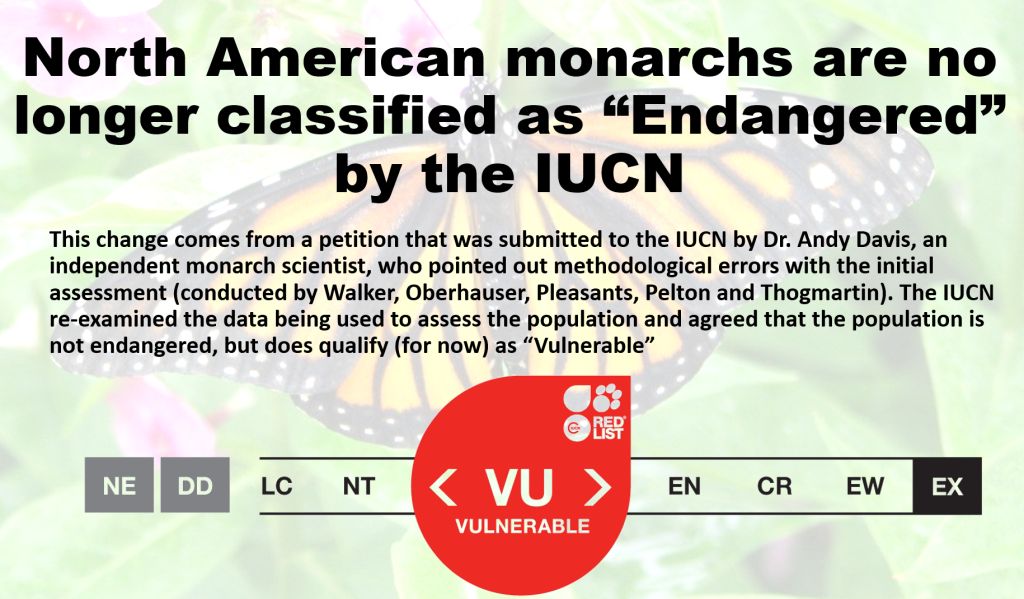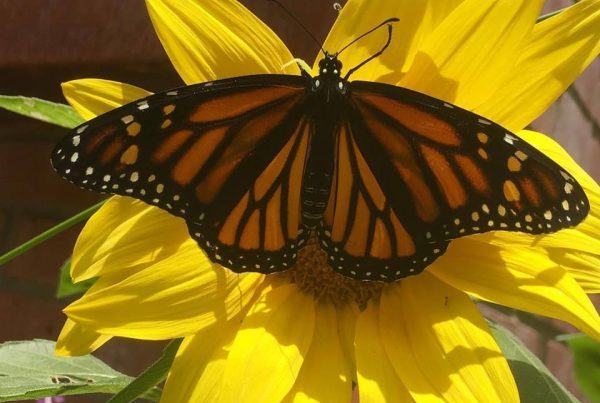The International Union for the Conservation of Nature revised its “endangered” listing of the monarch butterfly this week, labeling the iconic orange-and-black insect “vulnerable” rather than at risk of extinction.
The news was made public via social media when Andy Davis, migration studies expert and professor at the University of Georgia Odum School of Ecology, posted on his Thoughtful Monarch Facebook page that the challenge he had issued to the Switzerland-based conservation organization in January had been reviewed, resulting in the revision.
“The petition committee at the IUCN has just now ruled that monarchs in North America should not have been designated as endangered,” Davis wrote on September 27. “Instead, they recommended them to be listed as ‘vulnerable,’ which is a less-dire category.”
Davis noted that the decision was based on “the committee’s own statistical analysis of the monarch winter colony data, which was different than what the assessors used (and should have used).”
Davis submitted a counter petition challenging the endangered listing in January.
On Facebook, he relayed that in that challenge, he had argued that monarchs should be listed as a species of “least concern” based on his interpretation of data analysis, as well as winter colony sizes.
“They did not do this, and I’m thinking there were other reasons. So I guess this part leaves me less than excited,” Davis wrote.

–Photo via Facebook
Unlike when they announced monarch butterflies would be added to their IUCN Redlist of Threatened Species species last summer, the IUCN did not issue a press release announcing its delisting of the monarch to vulnerable.
Last year’s endangered news was announced in a July 21 press release, complete with a photo and “supporting quotes” from five different experts. The news made headlines around the world and caused increased concern in conservation circles as well as with citizen scientists and monarch butterfly aficionados, even though the IUCN has no regulatory authority.
IUCN staff did not respond to requests for comment or explanation as of this writing. The full ruling can be read online at the petitions page.
UPDATE 10/2/23 Monika Bohm of the IUCN clarified that the reason no press release was issued was that “the listing will be revised in time for the next IUCN Red List update, which is in December.” She shared via email that “the migratory monarch doesn’t have a revised assessment on the IUCN Red List website yet, and issuing a press release would be confusing if nothing else at this point. This is in keeping with all other petitions and subsequent changes and is not unusual.”
Bohm, a member if the IUCN SSC Butterfly & Moth Specialist Group, stated that “the change in listing makes little difference – we’re of course glad to see the migratory monarch not as much in peril as we thought it was, but at the same time it is definitely not out of the woods and is still a threatened species. This means that in terms of conservation action, we cannot take our foot off the pedal, and need to ensure that habitat, and native host plants etc persist for the species into the future.” She said the IUCN intends to reassess the status of the species in five years’ time.
Other monarch butterfly scientists weighed in on the listing change.
David James, associate professor of entomology at Washington State University, called the listing change “a very sensible decision.”
“‘Vulnerable’ describes the situation far better than ‘endangered’. ‘Endangered’ suggests extinction is on the horizon which it patently is not,” James shared via email. “The metrics from every source over periods of time from throughout the U.S. suggest we should maintain ‘watchful waiting’ while continuing to do all the restorative things everybody is doing and has been doing for a decade now,” he said.
When asked his thoughts on the revised listing, longtime monarch butterfly expert Chip Taylor, founder of Monarch Watch, the citizen science tagging program at the University of Kansas at Lawrence, replied “No comment.”
Monarch butterfly expert and University of Wisconsin-Madison Arboretum director Karen Oberhauser, who was on the committee that initially recommended the endangered listing, had thoughts on the IUCN change.
“Despite the ‘down-listing’ from endangered to vulnerable, a general consensus among most monarch scientists and external bodies (the IUCN and the USFWS) that monarchs are undergoing long-term declines,” Oberhauser shared via email. She added that the vulnerable status still translated into monarchs as a threatened species, vulnerable to myriad threats that could make them endangered, and in need of conservation attention.

Monarchs on Oyamel trees in Mexico. Photo by Verónica Prida
“The change in status was based on a different analysis of the data that gave more weight to the most recent decade, and the decline really occurred before that. I don’t think that most scientists would disagree with the science behind either analysis; they’re just different,” Oberhauser shared via email. “Monarchs are on the cusp between the two categories, but the actual category is less important than the conclusion that we should keep doing what we can to conserve this species.”
Davis, who issued the challenge to the endangered listing, was unsatisfied with the revision.
“It did not go far enough in my mind,” he shared via email, adding that he was considering submitting his own assessment to the IUCN “which would include data from all seasons, which is what the original assessors should have done. That would give a more complete picture of how the population is doing.”
TOP PHOTO: Monarch butterfly on sunflower. Photo by Monika Maeckle
Related posts:
- Monarch migration underway as new studies suggest butterflies are “not in danger”
- Q & A : Migration studies expert Andy Davis says, for monarchs, it’s survival of the biggest
- Recent IUCN “endangered” listing creates confusion for monarch butterfly followers
- Eastern monarch population up 35% this year, but still much work to do
- Dejavu: is 2022’s dry spring setting the stage for another Texas drought like 2011?
- Three monarch butterflies tagged in honor of those who died recovered in Mexico
- They’re here! Drought conditions greet monarch butterflies as they arrive in Texas
- Massive arrivals of monarch butterflies in the Texas Hill Country signal 2021 migration is on
- Courtship flights, late departures define recent visit to Piedra HErrada sanctuary
- Late, robust monarch butterfly migration evokes cautious optimism
Like what you’re reading? Don’t miss a single post from the Texas Butterfly Ranch. Sign up for email delivery, like us on Facebook, or follow us on Twitter, @monikam or Instagram.


Hmmm, sounds like sampling bias. Over-wintering colony is one important indicator of overall population stability. However, I’ve read some of Andy’s research and research from other scientists that show summer populations are stable, another important indicator. After including this latter research, IUCN revised their pronouncement. Where I get concerned is the amount of PR included with the endangered ruling, versus no PR surrounding the vulnerable ruling. Scientists are supposed to be liberal-minded in that we remain open to new evidence and support it with the same equanimity as previous findings.
I think Monika Bohm’s clarification above is a perfectly reasonable explanation of why there hasn’t been an IUCN press release.
Dr’s Andy Davis and Chip Taylor still believe the migration is endangered.
On NPR Radio on Sept. 29, 2023, Chip said: “We could easily lose this migration unless climate change is abated in some way.”
On June 30, 2023 on his Thoughtful Monarch Facebook page, Dr. Andy Davis wrote: “Probably the most important issue for monarchs right now is the national increase in OE prevalence. This disease is negatively affecting the entire North American population and literally destroying the migration.”
Those are opinions of what could happen, which is different than science indicating a certain status. In this case, their comments can also be considered as “vulnerable”. We’re all vulnerable to consequences of a changing environment.
There can never be a simple answer. Research must be ongoing. Curious humans and their day to day observations have an enormous contribution to be made toward valuing the contributions of the Monarchs.
[…] and in 2022 added it to the IUCN Red List as Endangered. However, IUCN then delisted monarchs in 2023, declaring them only […]